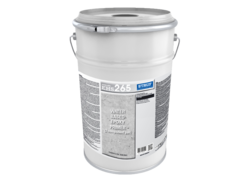EHS-265 Hydro-Seal
Water-Based Epoxy Primer (Two-Component Pail)
Special features
- For use under ULC-500 and coatings
- Superb penetration of subfloors
- Increases bond of subsequent products

Water-Based Epoxy Primer (Two-Component Pail)
Special features
| Product Description |
| STAUF EHS-265 Hydro-Seal is a two-component, hybrid-epoxy resin-based primer for subfloor preparation before installation of coatings and urethane-based leveling compounds. Unlike water or urethane-based primer, EHS-265 is unaffected by elevated subfloor moisture. It will not foam up or weaken because of water on the subfloor. It also has a higher concrete penetration than traditional 100% solid epoxies, creating a stronger bond. It does NOT create a moisture barrier but merely reduces the amount of vapor evaporation. EHS-265 spreads easily and creates a dust-free surface. It increases the bonding of subsequently applied coatings, urethane-based leveling compounds, and urethane and polymer-based adhesives. |
| Pre-Installation Checklist |
| A successful installation requires proper preparation of the subfloor. Read and understand all applicable guidelines and Technical Data Sheets before installation. |
| Sub Floor Examination |
| Do not apply the product to a visibly damp surface. Examine the concrete subfloor for color, cleanliness, porosity, and pre-existing residues PRIOR TO installation (see Technical Information #18 @ www.staufusa.com). Concrete subfloors must be checked for contaminants and/or anti-adherents using the STAUF Epoxy Test Kit (see Technical Information #16). |
| Prior to installation, the subfloor must be checked according to applicable installation guidelines. It must be solid, sound, clean, porous, free of chaps, anti-adherents, and resistant to pressure and tension. Confirm sufficient porosity by performing a water drop test according to ASTM F3191-16. Check for missing or compromised vapor barriers and hydrostatic pressure by carrying out RH or CaCl moisture tests following ASTM standards F1869-16 or F2170-19. Results of 99% RH or 25# CaCl could indicate a higher moisture content in the slab than what tests can measure, and there might be hydrostatic pressure and/or a compromised or missing vapor barrier. |
| Sub Floor Preparation |
| The subfloor's condition will determine which type of mechanical treatment is required (e.g., wire brushing, sanding, grinding, or shot blasting). Dust, paint, curing compounds, sealers, residual adhesives, or other surface contaminants MUST be removed, and a porous surface must be achieved by suitable means. The installer can only determine the extent of subfloor preparation at the site. Clean the surface with an industrial vacuum cleaner and tack the floor with a damp microfiber mop before application. Do not use sweeping compounds unless water-based, as most others contain oil or wax, which will act as an anti-adherent and prevent primers, sealers, leveling compounds, coatings, and/or adhesives from bonding to the concrete. Cracks and gaps must be treated before application of primers, sealers, leveling compounds, coatings, and/or adhesives (see Technical Information #19 @ www.staufusa.com). |
| Mixing of Components |
| The lid contains a hardener. Pierce all the way through the plastic disc in the center of the lid and the bottom of the lid using a long screwdriver or similar tool. Let the hardener flow into the lower part of the bucket for one minute. All of the hardener must drain into the pail before mixing Parts A&B. Open the ring, remove the lid, and mix both components with a mixing paddle for at least 3 minutes. Use an electric drill with less than 300 rpm until an even color is reached. Avoid air entrapment by mixing slowly and using an appropriate mixing paddle. Make sure to mix along the wall and bottom of the container as well. The temperature of both components should be at least 50°F before mixing. |
| Installation Procedure |
| Mix pail according to mixing instructions. Apply coating undiluted with an approved applicator. Make sure the coating is spread evenly and up to the perimeters. The spread rate is critical for a successful installation. Do not exceed the minimum or maximum coverage. |
| Storage |
| Store and transport protected from freezing. Recommended minimum temperatures are 35°F for transport and 40°F for storage. Do not stir the product if frozen, allow it to thaw completely. |
| Limitations |
| When using other than STAUF products in conjunction with STAUF primers, sealers, leveling compounds, or adhesives, STAUF denies any and all responsibility for any ensuing problems and/or damages without prior written authorization from STAUF. |
| Do not dilute primer/sealer or mix with other products. |
| In case of an accident, injury, spill, or exposure, see SDS for information. Consult the Technical Data Sheet at www.staufusa.com for updated information. |
| Sealer will not prevent moisture damage from hydrostatic pressure, missing or compromised vapor barriers, underground springs, damaged water pipes, sinks, icemakers, faulty plumbing, flooding, etc. |
| The foregoing representations are based on the results of our most current product and material testing within a controlled environment and are of a non-obligatory advisory nature only. As such, they do not constitute an express or implied warranty of any kind including the Warranty of Merchantability and/or Fitness for a Particular Purpose. Because we have no control over the actual quality of workmanship, materials used, and worksite conditions, STAUF USA LLC will in no event be liable for any incidental and/or consequential damages. Therefore, we strongly recommend that prior on-site testing be conducted to refer to and study the suitability of the product for the intended purpose. With the release of this Technical Information Sheet, all its prior versions become invalid. For warranty and warranty disclaimer information please see our Limited Lifetime Warranty @ www.staufusa.com |
|
|
||||||||||||||||||||||||||||||||||||||
| Revision: 2022-04-18 13:59:05 | |||||||||||||||||||||||||||||||||||||||